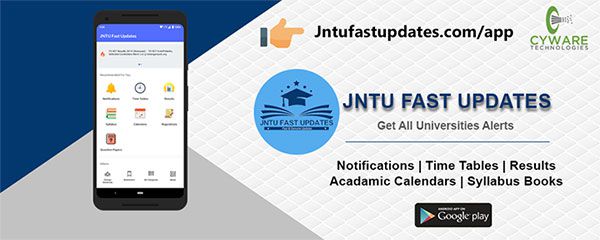JNTUK R20 2-2 Python Programming Material/Notes PDF Download
Students those who are studying JNTUK R20 EEE Branch, Can Download Unit wise R20 2-2 Python Programming Material/Notes PDFs below.

JNTUK R20 2-2 Python Programming Material/Notes PDF Download
Course Objectives:
- The Objectives of Python Programming are
- To learn about Python programming language syntax, semantics, and the runtime environment
- To be familiarized with universal computer programming concepts like data types, containers
- To be familiarized with general computer programming concepts like conditional execution, loops & functions
- To be familiarized with general coding techniques and object-oriented programming
Course Outcomes:
- Develop essential programming skills in computer programming concepts like data types, containers
- Apply the basics of programming in the Python language
- Solve coding tasks related conditional execution, loops
- Solve coding tasks related to the fundamental notions and techniques used in objectoriented programming
UNIT-1
Introduction: Introduction to Python, Program Development Cycle, Input, Processing, and Output, Displaying Output with the Print Function, Comments, Variables, Reading Input from the Keyboard, Performing Calculations, Operators. Type conversions, Expressions, More about Data Output.
Data Types, and Expression: Strings Assignment, and Comment, Numeric Data Types and Character Sets, Using functions and Modules.
Decision Structures and Boolean Logic: if, if-else, if-elif-else Statements, Nested Decision Structures, Comparing Strings, Logical Operators, Boolean Variables. Repetition Structures: Introduction, while loop, for loop, Calculating a Running Total, Input Validation Loops, Nested Loops.
Download UNIT-1 Material PDF |Reference-2 | Reference-3
UNIT-2
Control Statement: Definite iteration for Loop Formatting Text for output, Selection if and if else Statement Conditional Iteration The While Loop
Strings and Text Files: Accessing Character and Substring in Strings, Data Encryption, Strings and Number Systems, String Methods Text Files.
Download UNIT-2 Material PDF | Reference-2
UNIT-3
List and Dictionaries: Lists, Defining Simple Functions, Dictionaries Design with Function: Functions as Abstraction Mechanisms, Problem Solving with Top Down Design, Design with Recursive Functions, Case Study Gathering Information from a File System, Managing a Program’s Namespace, Higher Order Function.
Modules: Modules, Standard Modules, Packages.
Download UNIT-3 Material PDF | Reference-2
UNIT-4
File Operations: Reading config files in python, Writing log files in python, Understanding read functions, read(), readline() and readlines(), Understanding write functions, write() and writelines(), Manipulating file pointer using seek, Programming using file operations
Object Oriented Programming: Concept of class, object and instances, Constructor, class attributes and destructors, Real time use of class in live projects, Inheritance , overlapping and overloading operators, Adding and retrieving dynamic attributes of classes, Programming using Oops support Design with Classes: Objects and Classes, Data modeling Examples, Case Study An ATM, Structuring Classes with Inheritance and Polymorphism
Download UNIT-4 Material PDF | Reference-2
UNIT-5
Errors and Exceptions: Syntax Errors, Exceptions, Handling Exceptions, Raising Exceptions, User-defined Exceptions, Defining Clean-up Actions, Redefined Clean-up Actions.
Graphical User Interfaces: The Behavior of Terminal Based Programs and GUI -Based, Programs, Coding Simple GUI-Based Programs, Other Useful GUI Resources. Programming: Introduction to Programming Concepts with Scratch.
Download UNIT-5 Material PDF | Reference-2
e-Resources:
Text Books:
1) Fundamentals of Python First Programs, Kenneth. A. Lambert, Cengage.
2) Python Programming: A Modern Approach, Vamsi Kurama, Pearson.
Reference Books:
1) Introduction to Python Programming, Gowrishankar.S, Veena A, CRC Press.
2) Introduction to Programming Using Python, Y. Daniel Liang, Pearson.


320-x100(1).gif)
